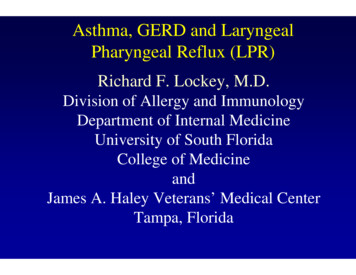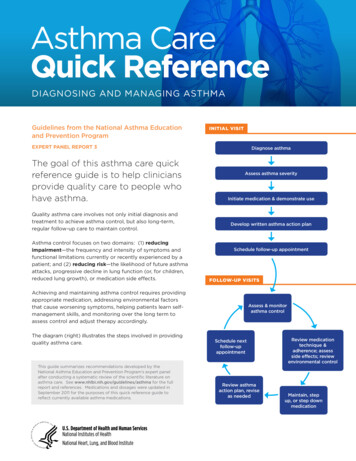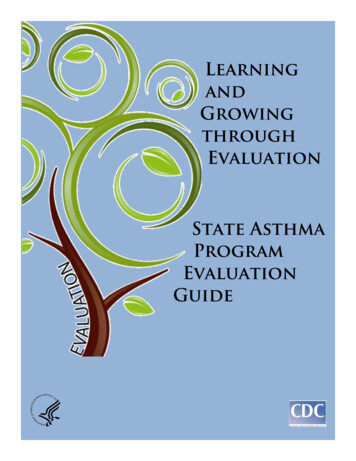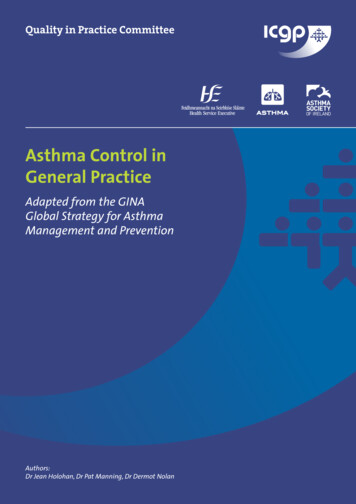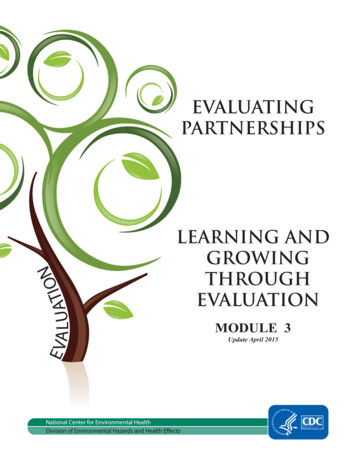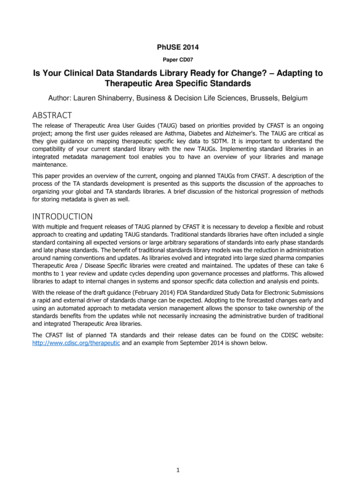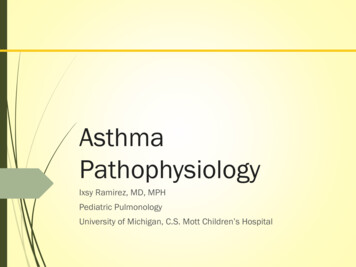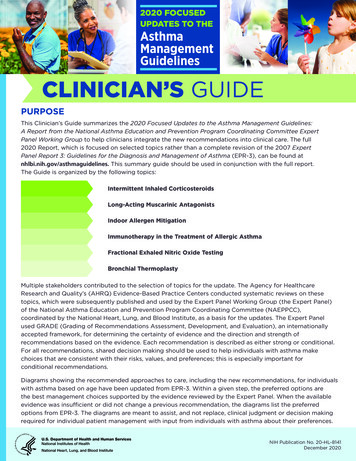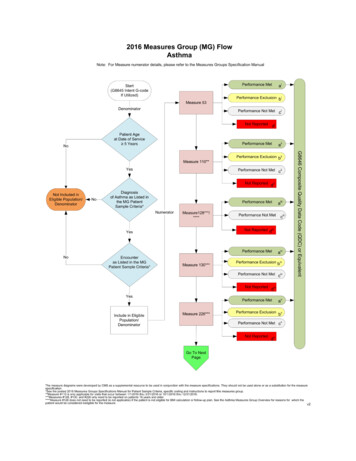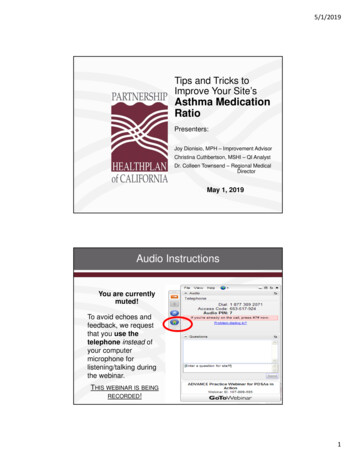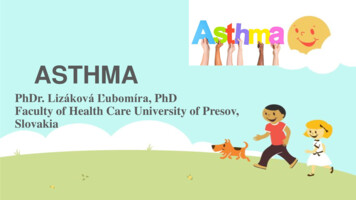
Transcription
ASTHMAPhDr. Lizáková Ľubomíra, PhDFaculty of Health Care University of Presov,Slovakia
What is ASTHMA?Do you know anything about asthma?
ASTHMA is a common long term inflammatory disease of the airways ofthe lungs. It is characterized by variable and recurringsymptoms, reversible airflow obstruction, and bronchospasm.Symptoms include episodes of wheezing, coughing. chesttightness, and shortness of breath. These episodes may occur a few times a day or a few timesper week. Depending on the person they may become worse atnight or with exercise
Signs and symptoms Asthma is characterized by recurrent episodes of wheezing, shortness ofbreath, chest tightness, and coughing. Sputum may be produced from thelung by coughing but is often hard to bring up. During recovery from anattack, it may appear pus-like due to high levels of white blood cellscalled eosinophils. Symptoms are usually worse at night and in the early morning or inresponse to exercise or cold air. Some people with asthma rarely experience symptoms, usually inresponse to triggers, whereas others may have marked and persistentsymptoms
Classification
Causes Environmental Hygiene hypothesis Use of antibiotics Genetic Medical conditions
Pharmacologic Therapy of Asthma Short-acting beta2 –adrenergic agonists. These are the medications of choice forrelief of acute symptoms and prevention of exercise-induced asthma. Anticholinergics. Anticholinergics inhibit muscarinic cholinergic receptors and reduceintrinsic vagal tone of the airway. Corticosteroids. Corticosteroids are most effective in alleviating symptoms, improvingairway function, and decreasing peak flow variability. Leukotriene modifiers. Anti Leukotrienes are potent bronchoconstrictors that alsodilate blood vessels and alter permeability. Immunomodulators. Prevent binding of IgE to the high affinity receptors of basophilsand mast cells.
Peak Flow Monitoring Peak flow meters. Peak flow meters measure the highest airflow duringa forced expiration. Daily peak flow monitoring. This is recommended for patients whomeet one or more of the following criteria: have moderate or severepersistent asthma, have poor perception of changes in airflow orworsening symptoms, have unexplained response to environmental oroccupational exposures, or at the discretion of the clinician or patient. Function. If peak flow monitoring is used, it helps measure asthmaseverity and, when added to symptom monitoring, indicates the currentdegree of asthma control.
Developmental Anatomy Lung and chest wall development (2-8 yrs)The proces of alveolization continues beyond the infant age: 20-50 milion alveoli at birth in a term infant 300 milion by the age of 8 yearsIncrease in alveolar surface area 2.8 m2at birth 32 m2at 8 years of age 75 m2by adulthood
Resistance: Kids vs Adults The main site of airway resistance in the adult is the upper airway;however, it has been shown that peripheral airway resistance in childrenyounger than 5 years of age is four times higher than adults the majorsite of resistance is the mediumsized bronchi
Key Function Oxygenation& Ventilation
The nursing care plan The nursing care plan focuses on preventing thehypersensitivity reaction, controlling the allergens,maintaining airway patency and preventing the occurrence ofreversible complications.
Nursing Interventions Assess history. Obtain a history of allergic reactions to medications beforeadministering medications. Assess respiratory status. Assess the patient’s respiratory status bymonitoring the severity of symptoms, breath sounds, peak flow, pulse oximetry,and vital signs. Assess medications. Identify medications that the patient is currentlytaking. Administer medications as prescribed and monitor the patient’sresponses to those medications; medications may include an antibiotic if thepatient has an underlying respiratory infection Pharmacologic therapy. Administer medications as prescribed and monitorpatient’s responses to medications. Fluid therapy. Administer fluids if the patient is dehydrated.
Nursing Interventions Assess the respiratory rate, depth, and rhythm - signs of impending respiratorydistress. Assess client’s level of anxiety - not being able to breathe properly. Assess breath sounds and adventitious sounds such as wheezes and stridor. Assess for signs of dyspnea (flaring of nostrils, chest retractions, and use ofaccessory muscle). Monitor oxygen saturation. Monitor arterial blood gasses. Plan for periods of rest between activities. Maintain head of bed elevated
Ineffective Breathing Pattern Inspiration and/or expiration that does not provide adequate ventilationPossibly evidenced by Cough. Cyanosis. Dyspnea, Nasal flaring. Prolonged expiration. Respiratory depth changes. Tachypnea. Use of accessory muscles.
Case Studies A 3-year-old boy presents to the emergency department because for thepast 24 hours he has had cough, wheeze, and increasing shortness ofbreath that began shortly after the onset of a low-grade fever andrhinorrhea. He is agitated and talking in short phrases only, with arespiratory rate of 40 per minute, a heart rate of 130 beats per minute,and oxygen saturation of 89% with the patient breathing room air.Examination of the chest reveals moderate intercostal and subcostalretractions. On auscultation, you note reduced breath sounds throughoutthe lung fields with widespread expiratory wheeze. Other than a clearnasal discharge, the remainder of the physical examination reveals noabnormalities.
What symptoms might indicaterespiratory distress in the child? past 24 hours he has had cough, wheeze, and increasing shortness of breath that began shortly after the onset of a lowgrade fever and rhinorrhea, he is agitated and talking in short phrases only, with a respiratory rate of 40 per minute, heart rate of 130 beats per minute, oxygen saturation of 89% with the patient breathing room air, moderate intercostal and subcostal retractions, note reduced breath sounds throughout the lung fields with widespreadexpiratory wheeze.
What other common related triggers tend to affectchildren and teenagers with asthma?
Nursing Diagnosis Ineffective airway clearance related to increased production of mucusand bronchospasm. Impaired gas exchange related to altered delivery of inspired O2. Anxiety related to perceived threat of death. Activity intolerance related to high respiratory demand as evidenced byincreased work of breathing and requirement for frequent rest whenplaying
Nursing intervention Auscultation of breath sounds and record sounds like crekels breath,wheezing. Assess respiratory frequency and depth of chest expansion. Record therespiratory effort including the use of auxiliary respiratory muscles / nasaldilation. Elevate the head and help change the position. Observation of the pattern of coughing and secretions character.
Evaluation To determine the effectiveness of the plan of care, evaluation must be performed. Thefollowing must be evaluated: Maintenance of airway patency. Expectoration or clearance of secretions. Absence /reduction of congestion with breath sound clear, noiseless respirations, andimproved oxygen exchange. Verbalized understanding of causes and therapeutic management regimen. Demonstrated behaviors to improve or maintain clear airway. Identified potential complications and how to initiate appropriate preventive orcorrective actions.
Rozloženieobrázksa spopisomPopis
https://nurseslabs.com/asthma-nursing-care-plans/ https://nurseslabs.com/asthma/ http://downloads.lww.com/wolterskluwer vitalstream com/samplecontent/9780781751155 Kyle/samples/Kyle-3735 19 CH19redo.pdf
Ineffective airway clearance related to increased production of mucus and bronchospasm. Impaired gas exchange related to altered delivery of inspired O2. Anxiety related to perceived threat of death. Activity intolerance related to high respiratory demand as evidenced by increased work of breathing and requirement for frequent rest when

